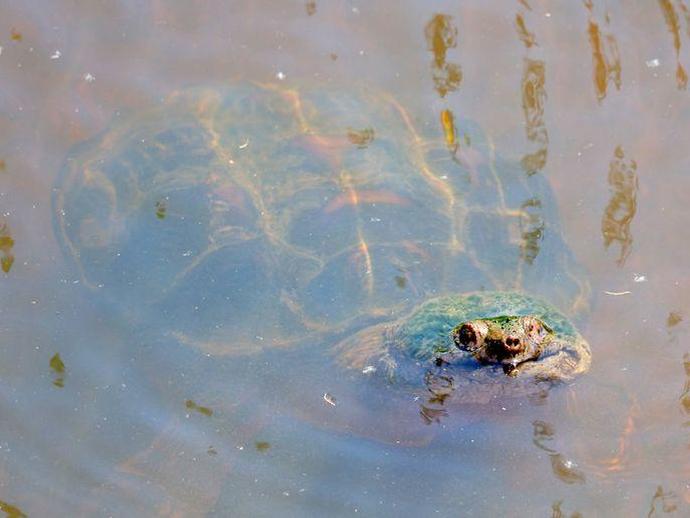May 11, 2021
It's time for the Tuesday edition of #BenInNature presented by our friends at Carter Bank & Trust!
Here's another cool find from my recent trip to Phinizy Swamp Nature Park in Augusta, Georgia: Chelydra serpentina, the common snapping turtle!
Common snapping turtles can also be found in Virginia, and they're pretty common throughout the eastern two-thirds of the U.S. You might occasionally see them crossing the road, or -- like this one -- you might see them in shallow water, occasionally poking their snout above the waterline and using it like a snorkel.
Snapping turtles are pretty indiscriminate when it comes to their diets, and they'll often scavenge for plant or animal matter. However, they'll also eat anything they can swallow, including fish, frogs, snakes, other turtles, and even birds and small mammals! Once they reach adulthood, they don't have much in the way of predators (except for man), but a number of predators and scavengers will feed on the eggs and juveniles.
There are unfortunately a bunch of misconceptions about snapping turtles. One misconception is that they're vicious both in the water and out of the water. As it happens, you don't have too much to fear from snapping turtles in the water; their first instinct is to flee and hide if threatened. However, they're ungainly on land and will defend themselves if threatened, and they do have a powerful bite.
To avoid getting bitten, the best strategy is to simply avoid them. Unfortunately, snapping turtles sometimes wind up in the middle of the road, and kind-hearted folks often want to move them to safety. Contrary to popular belief, picking these turtles up by their tails can hurt them pretty severely, injuring not only the tail but possibly the spinal column. Another misconception is that it's safe to let a turtle bite a stick and then drag it off the road; this can scrape the turtle's legs or shell, which can lead to infection.
The best way to move a snapping turtle is to coax it into the middle of a sheet or a tarp and then pick up the corners of the sheet and carry it off the road. If you don't have a sheet, you can also pick up the turtle by the very back of the shell using the large gaps that are above its hind legs. Never pick up a snapping turtle by the sides of the shell, because their necks are surprisingly long and they can give you a bite!
Of course, as with all wild animals, the best strategy of all is to simply leave them alone and enjoy them from a distance.
ABOUT #BenInNature
Social distancing can be difficult, but it presents a great opportunity to become reacquainted with nature. In this series of posts, Administrator of Science Ben Williams ventures outdoors to record a snapshot of the unique sights that can be found in the natural world. New updates are posted Monday - Friday, with previous posts highlighted on the weekends. This series of posts is made possible thanks to the support of VMNH Corporate Partner Carter Bank & Trust (www.cbtcares.com).
NATURE PHOTO IDENTIFICATIONS
If you discover something in nature that you would like help identifying, be sure to message us right here on Facebook with a picture (please include location and date of picture) and we'll have our experts help you identify it!

 Hours & Admissions
Hours & Admissions Directions
Directions

